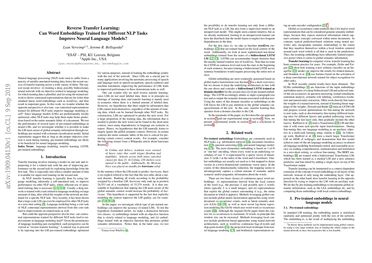Reverse Transfer Learning: Can Word Embeddings Trained for Different NLP Tasks Improve Neural Language Models?
Natural language processing (NLP) tasks tend to suffer from a paucity of suitably annotated training data, hence the recent success of transfer learning across a wide variety of them. The typical recipe involves: (i) training a deep, possibly bidirectional, neural network with an objective related to language modeling, for which training data is plentiful; and (ii) using the trained network to derive contextual representations that are far richer than standard linear word embeddings such as word2vec, and thus result in important gains. In this work, we wonder whether the opposite perspective is also true: can contextual representations trained for different NLP tasks improve language modeling itself? Since language models (LMs) are predominantly locally optimized, other NLP tasks may help them make better predictions based on the entire semantic fabric of a document. We test the performance of several types of pre-trained embeddings in neural LMs, and we investigate whether it is possible to make the LM more aware of global semantic information through embeddings pre-trained with a domain classification model. Initial experiments suggest that as long as the proper objective criterion is used during training, pre-trained embeddings are likely to be beneficial for neural language modeling.
PDF Abstract



